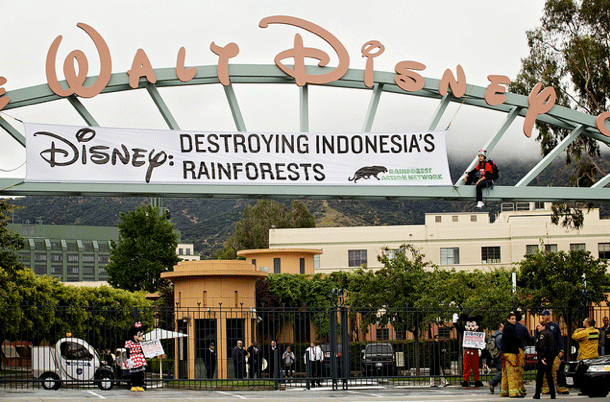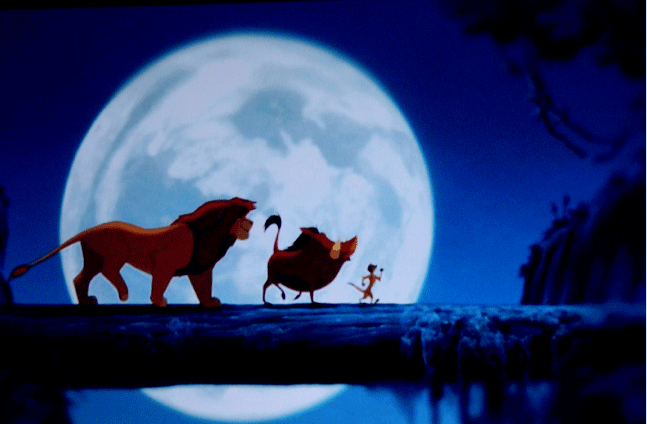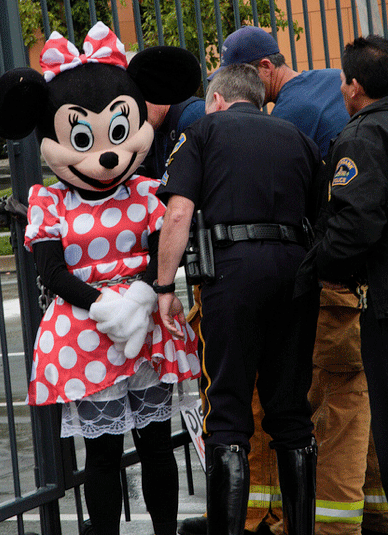Disney’s Commitment to the Circle of Life
Air Date: Week of October 19, 2012

Activists with Rainforest Action Network (RAN), costumed as Mickey and Minnie Mouse, blocked the entrance to the Walt Disney Company's headquarters as two other activists unfurled a banner reading, “Disney: Destroying Indonesia’s Rainforests.” (Rainforest Action Network)
Two years ago nine of the top ten American publishers of children’s books — including Disney — used paper from endangered rainforests. Most of the publishers have now committed to sustainable paper and Disney has just announced it will also stop buying paper linked to rainforest destruction. Robin Averbeck, Forest Campaigner for the Rainforest Action Network, tells host Steve Curwood how the organization helped Disney to develop its new paper policy.
Transcript
CURWOOD: In the Lion King, Disney celebrates the Circle of Life that moves us all. Well now the Disney Company itself is moving towards a new sustainability. After negotiations in the wake of protests from the Rainforest Action Network, Disney has announced it will reduce paper use, and make sure all it does use is responsibly sourced and harvested.
Disney, creator of many stories that inspire children’s love of nature, is the world’s largest publisher of children’s books. But a 2010 study found that nine of the ten top American publishers of children’s books – including Disney – used paper made from trees in Indonesia’s endangered rainforests. Robin Averbeck is the Forest Campaigner for the Rainforest Action Network. Welcome to Living on Earth!
AVERBECK: Hi there Steve!

Disney’s The Lion King. (Photo: Robbie Gunn)
CURWOOD: So, last year, activists as I understand it, they dressed up as Mickey and Minnie Mouse and they locked themselves to the gates of Disney headquarters there in Los Angeles and hung a banner that read: “Disney Destroying Indonesia’s Forests.” Disney dismissed it as a publicity stunt, but why has Disney had a change of heart since the protests?

A Rainforest Action Network activist dressed as Minnie Mouse was arrested while protesting Disney rainforest destruction. (Rainforest Action Network)
AVERBECK: Disney, you know, really didn’t realize that they were getting paper from Indonesia. And the fact that they were producing books, kids books nonetheless, books about rainforests that contained Indonesian rainforests in them. And so it took a little bit of time for them to understand the issue, to understand how this was ending up in their books and really… Minnie and Mickey arriving on their doorstep to deliver this message in no uncertain terms was a huge wake-up call for them and for their executives.
CURWOOD: To what extent were you involved in the original protest?
AVERBECK: I was there, on-site, as a spokesperson, a supporter to the activists, so I was quite involved. I had the first-hand experience of seeing Minnie carted away in handcuffs, it was quite entertaining. But, just the visuals, the fact that Minnie was there to protest Indonesian rainforest destruction, herself, basically meant that the executives could not ignore this issue anymore.
CURWOOD: How big is Disney’s book business?
AVERBECK: Disney is the world’s largest children’s book and magazine publisher. So, that’s a lot of paper. And in addition to that, they are the largest owner of theme parks, the biggest licenser of toys, and so all of that is a lot of paper.
CURWOOD: So, what is the deal now? Disney is going to use all sustainable trees in all of its operations?
AVERBECK: Basically they’re saying: Where possible we’re going to source the sources that we know are really good, like recycled paper. Then, in other cases, they have set out a whole set of principles that say: These are absolutely the type of paper sources we don’t want to be involved in. We don’t want to be involved in paper where human rights are being violated, we don’t want to be involved in buying paper where natural forests are being converted to monoculture tree plantations. And so they basically set out a whole list of unwanted sources - is what they call them in the policy.
CURWOOD: Now, Disney is a large, large, large company. I think their sales are on the scale of 40 billion dollars a year, publishing kids books, but also they own ABC television. Does this policy mean that when they’re reading the scripts there on Good Morning America that it will be from recycled paper - it won’t be from rainforest?
AVERBECK: That’s absolutely true. This policy means that everything from the paper that’s in a theme park map in Tokyo to exactly the scripts in ABC studios in LA, to the packaging that’s used to wrap a princess doll in Russia. All of those things are going to be on paper that meets Disney’s new policy.
CURWOOD: At the end of the day, how much will Disney’s decision impact the rates of deforestation in places like Indonesia?
AVERBECK: Well, we hope a lot. Disney manufactures its products in, you know, 25,000 factories around the world. And that means that that message is going to be sent throughout a very, very wide supply chain and reach 25,000+ suppliers.
CURWOOD: To what effect is Disney’s new policy on paper going to affect endangered species in these regions?
AVERBECK: Well, in Indonesia specifically, this means that Disney is not going to be sourcing from any area that is, for example, habitat for Sumatran Tigers. Sumatran Tigers are directly threatened by the Indonesian pulp and paper industry. And, more widely than Indonesia, Disney’s paper policy means that they won’t be sourcing from high-value conservation areas, which is a lot of the critical habitat that’s left for these animals.
CURWOOD: Now that the Rainforest Action Network has proven that sustainable paper is not Mickey Mouse, what’s your next move?
AVERBECK: This policy itself is creating a lot of momentum. Basically, you know, if Disney can do something like this, a company as large as Disney, there’s no reason that other companies can’t do the same. Very specifically, in the publishing industry, you know, we’ve gotten nine of the top ten publishers to make a similar rainforest commitment, and the one remaining laggard is Harper Collins. So we certainly plan to profile HarperCollins inaction compared to its colleagues.
CURWOOD: What does HarperCollins say when you ask them to join their colleagues in the publishing profession?
AVERBECK: Well, HarperCollins has largely ignored us. We have been in conversation with them for multiple years at this point, and they have been unwilling to take public action.
CURWOOD: Robin, what Disney character did you grow up with?
AVERBECK: I grew up with a lot of Disney characters. I remember being particularly fond of the Lion King movie when it came out. So, Simba, Simba was close, near and dear to my heart.
CURWOOD: So, how does it feel now that you have protected Simba’s habitat?
AVERBECK: You know, I had a moment, when, early on in our engagement, about two months after we entered into negotiations Disney put out a statement to its suppliers urging them not to source from Indonesia. And one of their team members called me and said: “We’re sorry that this is taking us so long, it’s taken us three weeks to translate this into the number of languages it needs to be translated into to send out to all of our suppliers.”
And that for me was a moment of realization about just how enormous the impact of this, and the impact of Disney as a company, could be.
CURWOOD: And so now you believe Walt Disney: When you wish upon a star!
AVERBECK: (Laughs.) Uh, in the case of this paper purchasing policy, I certainly do!
CURWOOD: Robin Averbeck is a forest campaigner for the Rainforest Action Network, the organization that worked with Disney to develop its new paper policy. Thank you so much, Robin.
AVERBECK: Thank you so much Steve.
CURWOOD: We contacted HarperCollins. They didn’t comment about the Rainforest Action Network, but they did email this statement:
HarperCollins paper procurement policies support the general goals of environmentally sustainable fiber use, reducing pollution, and conserving natural resources through recycling and waste reduction. We use only acceptable fiber sources, and have worked with printers to eliminate the use of Indonesian fiber from books produced for HarperCollins.
Links
The Rainforest Action Network’s press release on Disney’s new sustainable paper policy
Living on Earth wants to hear from you!
Living on Earth
62 Calef Highway, Suite 212
Lee, NH 03861
Telephone: 617-287-4121
E-mail: comments@loe.org
Newsletter [Click here]
Donate to Living on Earth!
Living on Earth is an independent media program and relies entirely on contributions from listeners and institutions supporting public service. Please donate now to preserve an independent environmental voice.
NewsletterLiving on Earth offers a weekly delivery of the show's rundown to your mailbox. Sign up for our newsletter today!
 Sailors For The Sea: Be the change you want to sea.
Sailors For The Sea: Be the change you want to sea.
 The Grantham Foundation for the Protection of the Environment: Committed to protecting and improving the health of the global environment.
The Grantham Foundation for the Protection of the Environment: Committed to protecting and improving the health of the global environment.
 Contribute to Living on Earth and receive, as our gift to you, an archival print of one of Mark Seth Lender's extraordinary wildlife photographs. Follow the link to see Mark's current collection of photographs.
Contribute to Living on Earth and receive, as our gift to you, an archival print of one of Mark Seth Lender's extraordinary wildlife photographs. Follow the link to see Mark's current collection of photographs.
 Buy a signed copy of Mark Seth Lender's book Smeagull the Seagull & support Living on Earth
Buy a signed copy of Mark Seth Lender's book Smeagull the Seagull & support Living on Earth

